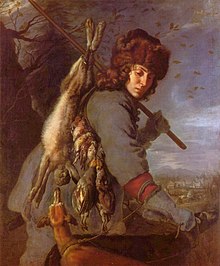Ushanka
This article needs additional citations for verification. (March 2009) |
An ushanka (Russian: уша́нка; pronounced [uˈʂankə]) is a Russian fur cap with ear flaps that can be tied up to the crown of the cap, or tied at the chin to protect the ears, jaw and lower chin from the cold.
The word Ushanka derives from ushi (у́ши), "ears" in Russian.
-
Formal and closed setup of Ushanka worn with the Winter version of the Afghanka
-
Soviet Army-Ushanka, as worn under helmet Babruysk, 1988
-
Ear-free but protecting Neck
Historical use


Hats with flexible earflaps made out of fur are found in Russia as well as in Germany and Scandinavia.
During the Russian Civil War, when Aleksandr Kolchak ruled in Siberia, he introduced a winter uniform hat, commonly referred to as kolchakovka, which was basically an ushanka with an extra eye-flap.
The categorization as "Russian Cap" is a result of World War II. During the Winter War with Finland 1939 thousands of Russians died of cold due to organizational failures and inadequate equipment. Reforms were undertaken and the Red Army introduced new winter uniform, which included ushanka to replace budyonovkas. German soldiers started to use this and other gear unofficially,[1] though copies were introduced rather late in the war.
Basic materials
Ushankas are often made from cheap sheepskin (tsigeyka, ru:Цигейка), rabbit or muskrat fur, though artificial fur hats are also manufactured. Artificial fur has sometimes been referred to as "fish fur"[2] since the material has no relation to any real fur. The simplest "fish fur" of ushankas was made of wool pile with cloth substrate and cloth top, with the exception of flaps, in which pile was exposed.
Popular Culture

Though ushankas are a distinctly Russian hat (indeed, the stereotypical Russian is seen to wear one) the wearing of fur caps of similar design was relatively common throughout China, North Korea, Eastern Europe.
The Ushanka became a symbol and media icon of Soviet Russia. Photographs of US President Gerald Ford wearing the cap during a 1974 visit to the Soviet Union were seen as a possible sign of Détente. In 1991, with the fall of the Soviet Union came the first wave of commercially imported Russian winter hats into the United States. [citation needed]
A green Ushanka is seen as almost a trademark worn by South Park character Kyle. It has become so widely associated with the character that the show's younger audience have deemed it a "Kyle Hat."




